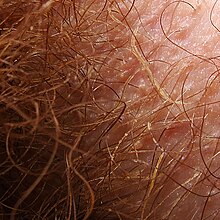Trichobacteriosis axillaris

| Trichobacteriosis axillaris | |
|---|---|
 | |
| An armpit with variably encrusted hairs | |
| Specialty | Dermatology |
Trichobacteriosis axillaris is a superficial bacterial colonization of the hair shafts in sweat gland–bearing areas, such as the armpits and the groin. It is a trivial disease of worldwide occurrence that is believed to be caused by the genus Corynebacteria.[1]
The condition has been called extensively trichomycosis axillaris in the literature, but because it is a bacterial infection and not a fungal infection, it should be called trichobacteriosis.[2]
Presentation
[edit]It is characterized by the presence of concretions along the hair shafts, clinically observed as yellow, and rarely as red or black nodules. These concretions derive from bacterial colonization along the hair shaft containing dried apocrine sweat with a cementing substance generated by the bacteria.[2]
Cause
[edit]It is caused by several species of Corynebacterium.[2]
Obesity, hyperhidrosis, poor local hygiene, and warm, moist environments are common predisposing factors.[3]
Diagnosis
[edit]The infection is diagnosed by close examination of the hair shafts where brown to yellow material called concretions are seen. There is usually an associated rancid odour. A microscopic examination can confirm the diagnosis, but this is rarely needed.[4]
Some patients with excessive sweating present the so-called corynebacterial triad, that is, the simultaneous presence of trichobacteriosis axillaris, erythrasma, and pitted keratolysis.[5]
Treatment
[edit]No specific therapeutic studies on trichobacteriosis are available.[6]
Many authors consider that the most effective treatment consist in shaving of the affected area for a period of 2–3 weeks.[4][7] The use of a concomitant treatment, such as sulfur soaps or benzoyl peroxide[8] is also recommended.[2] Rubbing whilst washing may help to disrupt the biofilm, hence increasing the accessibility of antiseptics to the bacteria.[6]
Patients who shave the affected area only once will generally experience a recurrence of the infection, since, the bacteria begin to develop the concretions once again as the hair grows back.[2]
Corynebacterium infections are related to excessive sweating; for this reason, deodorants containing an aluminum chloride solution may be used for treatment and prevention.[7]
Maintaining good local hygiene is recommended.[4]
See also
[edit]References
[edit]- ^ Rapini RP, Bolognia JL, Jorizzo JL (2007). Dermatology: 2-Volume Set. St. Louis: Mosby. p. 1089. ISBN 978-1-4160-2999-1.
- ^ a b c d e Bonifaz A, Váquez-González D, Fierro L, Araiza J, Ponce RM (January 2013). "Trichomycosis (trichobacteriosis): clinical and microbiological experience with 56 cases". International Journal of Trichology. 5 (1): 12–6. doi:10.4103/0974-7753.114704. PMC 3746219. PMID 23960390.
- ^ Ma DL, Vano-Galvan S (October 2013). "Images in clinical medicine. Trichomycosis axillaris". The New England Journal of Medicine. 369 (18): 1735. doi:10.1056/nejmicm1300241. PMID 24171519.
- ^ a b c Huang CF, Liaw FY, Liu YC, Wang WM (2013). "Answer: Can you identify this condition?". Canadian Family Physician. 59 (6): 648. PMC 3681455.
- ^ Rho NK, Kim BJ (February 2008). "A corynebacterial triad: Prevalence of erythrasma and trichomycosis axillaris in soldiers with pitted keratolysis". Journal of the American Academy of Dermatology. 58 (2 Suppl): S57–8. doi:10.1016/j.jaad.2006.05.054. PMID 18191714.
- ^ a b Blaise G, Nikkels AF, Hermanns-Lê T, Nikkels-Tassoudji N, Piérard GE (September 2008). "Corynebacterium-associated skin infections". International Journal of Dermatology. 47 (9): 884–90. doi:10.1111/j.1365-4632.2008.03773.x. PMID 18937649. S2CID 19056660.
- ^ a b Barboza-Guadagnini L, Fernández-Figueras MT, Bassas-Vila J (September 2015). "Creamy Yellow Concretions in Axillary Hair". JAMA Dermatology. 151 (9): 1023–4. doi:10.1001/jamadermatol.2015.0989. PMID 25970422.
- ^ Swart MN, Weinberg AN. Bacterial diseases with cutaneous involvement. In: Fitzpatrick’s Dermatology in General Medicine, 6th edn. New York: McGraw-Hill, 2003: 1843–1878.